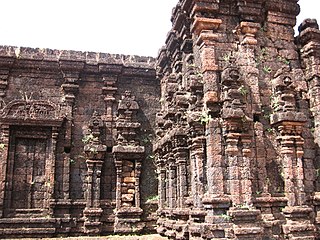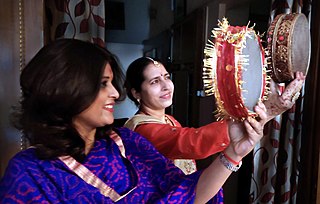
Maha Shivaratri is a Hindu festival celebrated annually in honour of the god Shiva. The name also refers to the night when Shiva performs the heavenly dance called Tandava.

Jyeshtha or Jyēṣṭha is a month of the Hindu calendar. In India's national civil calendar, Jyestha is the third month of the year. Known as Joishtho in Bengali, it is the second month of the Bengali calendar.

Śrāvaṇa is the fourth month of the Hindu calendar. In India's national civil calendar, Śrāvaṇa is the fifth month of the Hindu year, beginning in late July from the first day of the full moon and ending in the third week of August, the day of the next full moon. In the Tamil calendar, it is known as Āvani and is the fifth month of the solar year. In lunar religious calendars, Śrāvaṇa begins on the new moon and is the fourth month of the year. Srabon is the fourth month of the Bengali calendar. It is also the fourth month of the Nepali calendar. This is also the second month of Varsha (rainy) season.

Karthika Deepam, Thrikarthika or Karthikai Vilakkidu is a festival of lights that is observed by Hindus of Tamil Nadu, Kerala, Andhra Pradesh, Telangana, Karnataka and Sri Lanka. Tamil Nadu celebrates Karthigai Deepam as a traditional festival. It is a very ancient festival and is also celebrated in the neighboring states of Kerala, Andhra Pradesh and Karnataka. This festival is very important for Tamils all over the world. The full moon day of this Karthigai month is called Karthigai pournami. In Kerala, this festival is known as Thrikkarthika, celebrated to welcome Goddess Karthiyayeni Bhagavathi. In the rest of India, a related festival called Kartik Purnima is celebrated in a different date. It is celebrated in the name of 'Lakshabba' in the Nilgiris district of Tamil Nadu. The name of the festival born from the name of the god Kartikeya. In Tamil calendar the name of this month is Kārthikai (கார்த்திகை). In Telugu households of Andhra Pradesh, Telangana, Karthika Maasalu (month) is considered very auspicious. The Kartikai month starts on the day of Deepavali. From that day till the end of the month, oil lamps are lit every day. On Karthikai Pournami oil lamp with 365 wicks, prepared at home, are lit in Lord Shiva temples. Apart from that, on Kartikai Pournami fasting is observed till sunset, every day for the whole month. Swaminarayan Sampraday also celebrates this day with faith and fervor.[7]

Naga Panchami is a day of traditional worship of Nagas or snakes observed by Hindus, Jains, and Buddhists throughout India, Nepal, and other countries where Hindu, Jain, and Buddhist adherents live. The worship is offered on the fifth day of bright half of lunar month of Shravana (July/August), according to the Hindu calendar. Some Indian states, such as Karnataka, Rajasthan and Gujarat, celebrate Naga Panchami on the dark half of the same month. As part of the festivities, a Naga or serpent deity made of silver, stone, wood, or a painting of snakes is given a reverential bath with milk and their blessings are sought for the welfare of the family. Live snakes, especially cobras, are also worshipped on this day, especially with offerings of milk and generally with the assistance of a snake charmer.

Hanuman Janmotsav is a Hindu religious festival that celebrates the birth of Hindu God Hanuman, who is highly venerated throughout India and Nepal. This festival is celebrated on different days in different parts of India. In most states of India, the festival is observed either in Chaitra or In Karnataka, Hanuman Janmotsav is observed on Shukla Paksha Trayodashi during Margashirsha month. The day is popularly known as Hanuman Vratamor in Vaishakha, while in a few states like Kerala and Tamil Nadu, it is celebrated in Dhanu.

The Rajarajeshwara temple is a Shiva temple located in Taliparamba in Kannur district of Kerala, India. The temple is regarded as one of the existing 108 ancient Shiva Temples of ancient Kerala. It also has a prominent place amongst the numerous Shiva temples in South India. It had the tallest shikhara amongst the temples of its time. The Rajarajeshwara temple has a top of about 90 tonnes. If any problem is encountered in the other temples of South India, devotees seek a solution in this temple through a prashnam, a traditional method of astrological decision making. The prashnam is conducted on a peedha outside the temple.
Azhakodi Devi Temple is a Hindu temple in Thiruthiyadu, Thiruthiyadu, Kozhikode, Kerala, India. It is about 1.5 km away from the Mofussil bus stand and 2.5 km from the KSRTC Bus stand in the Kozhikode city.

Karwa Chauth is a festival celebrated by Hindu women of Northern and Western India on the fourth day after Purnima in the month of Kartika. Like many Hindu festivals, Karwa Chauth is based on the lunisolar calendar which accounts for all astronomical positions, especially positions of the moon which is used as a marker to calculate important dates. The festival falls on the fourth day after the full moon.

Amāvásyā is the lunar phase of the new moon in Sanskrit. Indian calendars use 30 lunar phases, called tithi in India. The dark moon tithi is when the Moon is within 12 degrees of the angular distance between the Sun and Moon before conjunction (syzygy). The New Moon tithi is the 12 angular degrees after syzygy. Amāvásyā is often translated as new moon since there is no standard term for the Moon before conjunction in English.

Gangaur is a festival celebrated in the Indian state of Rajasthan and Nimaar region of Madhya Pradesh. It is also celebrated in some parts of Gujarat and West Bengal.

Teej is the generic name for a number of Hindu festivals that are celebrated by women. Haryali Teej and Hartalika Teej welcome the monsoon season and are celebrated primarily by girls and women, with songs, dancing and prayer rituals. The monsoon festivals of Teej are primarily dedicated to Parvati and her union with Shiva. Women often fast in celebration of Teej. Hartalika Teej is celebrated in all parts of Nepal and most of the parts of North India. Teej festivals are traditionally observed by women to celebrate the monsoons during the months of Shravan and Bhadrapada of Hindu calendar. Women often pray to Parvati and Shiva during Teej.
This article lists the traditional festivals and other cultural events in the Odisha region of India. Odisha celebrates 13 festivals in 12 months as the saying goes Bāra Māsare Tera Parba.

Kapila Theertham is a famous Saivite Temple and Theertham, located at Tirupati in the Tirupati District of Andhra Pradesh, India. The idol is believed to be installed by Kapila Muni and hence Lord Siva here is referred to as Kapileswara.

Swetharanyeswarar Temple is a Hindu temple dedicated to the deity Shiva, located in Thiruvenkadu, a village in Mayiladuthurai district in the South Indian state of Tamil Nadu. Shiva is worshiped as Swetharanyeswarar, and is represented by the lingam. His consort Parvati is depicted as Brahmavidyambigai. The presiding deity is revered in the 7th century Tamil Saiva canonical work, the Tevaram, written by Tamil saint poets known as the Nayanars and classified as Paadal Petra Sthalam. It is significant to the Hindu sect of Saivism as one of the temples associated with the nine planet elements, the Navagraha Stalas, and specifically Budha.

Lakshmi Pooja, is a Hindu religious festival that falls on Amavasya in the Vikram Samvat Hindu calendar month of Kartik, on the third day of Deepawali and is considered as the main festive day of Deepawali, however in Assam, Bengal, and Odisha this puja is celebrated 5 days after Vijaya Dashami.

Varalakshmi Vratam/ Vara Mahalakshmi Vrata is a festival to propitiate the Goddess Lakshmi. Varalakshmi is one who grants boons ("Vara"). It is an important pooja performed by many women in the states of Karnataka, Andhra Pradesh, Telangana, Tamil Nadu and northern Sri Lanka. The Hindu festival going by the name 'Vara MahaLakshmi Vrata' is celebrated on the Second Friday or the Friday before the day of the full moon - Poornima - in the month of Shravana, which corresponds to the Gregorian months of July–August.

Thiruvathira or Thiruvathirai or Arudhra Darisanam is a Hindu festival celebrated in the Indian states of Kerala and Tamil Nadu. Thiruvathirai (Arudhra) in Tamil means "sacred big wave". Chidambaram in Tamil Nadu, the Sri Natarajar temple's annual Festival, is celebrated on this date. In the month of Makaram Thiruvathira Star is celebrated in Mathira Peedika Devi Temple, owned by Thiruvithamcore Devaswom Board, near Kadakkal in Kollam District of Kerala state. Thiruvathira has a connection with lord moon.
Haragapur is a village in Belgaum district in the southern state of Karnataka, India. It is attached to NH-4. Places to visit are Shivaji Fort, Mallikarjun Temple & Navanath Mandir. Village is located on Hilltop. Language spoken here is Kannada (ಕನ್ನಡ)

Savitri Vrata or Savitri Amavasya is a fasting day observed by married Hindu women on the Amavasya, the no moon day in month of Jyeshtha. It is celebrated in the Indian states of Odisha, Bihar, Uttar Pradesh and in Nepal. It is also known as Sabitri Uwaans in Western Odisha region.
















